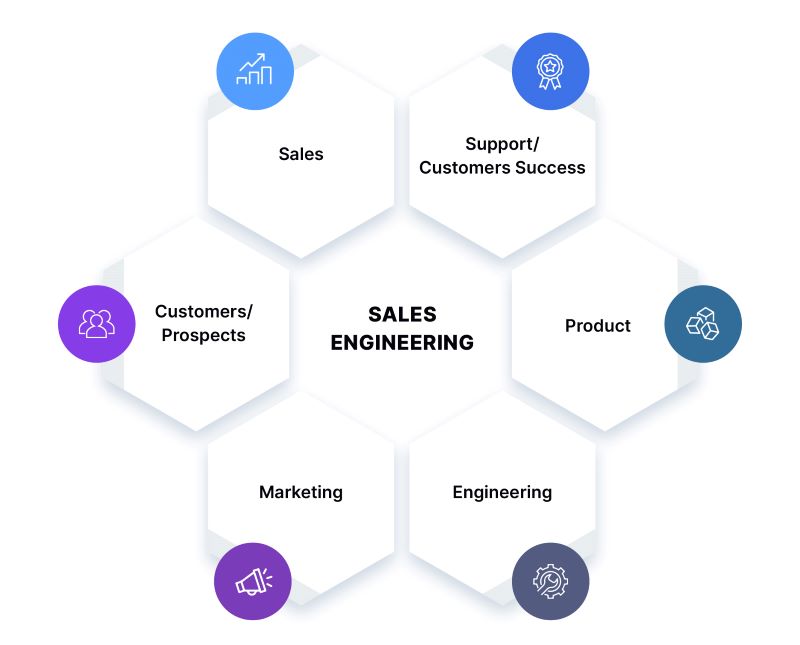Level Up Your Presence: Top Virtual Selling Tips for Sales Engineers

roombriks team
Here are best practices for B2B virtual selling to ensure a successful sales process.

Get the best Pre Sales Questions Template
Summary
This article outlines best practices for preparing and conducting successful virtual client meetings. While the pandemic propelled virtual selling into the norm, many of these principles were relevant even before that shift.
We understand the diverse range of client meetings you encounter. This guide aims to provide a general structure applicable to most situations, helping you avoid redundancy and maximize the value of each interaction.
Be Prepared
In the ideal scenario, you should have ample time to gather information and set a clear agenda before the meeting. Gather essential digital correspondence (marketing materials, documentation, case studies, etc.) relevant to the agenda beforehand. Sharing these materials ahead of time in your digital collaboration room is optimal.
This proactive approach provides mutual benefits for both parties. It facilitates better preparation, increases engagement, and leads to a more efficient use of time.
Be prepared with questions related to the customer, tailored to the specific meeting topic and agenda. If you’re struggling to formulate questions, consider some of the examples below.
Sometimes you are thrown into a meeting with short notice. Here are some open-ended questions for a pre-sales engineer in the discovery process that most customers can answer easily with little prep:
Understanding context and pain points:
Current State:
Could you walk me through how you currently handle xyz? What tools are you using? How has the process been going so far? Also, could you share insights into the most significant challenge you face when dealing with xyz
Negative Impacts:
Could you unpack the xyz challenge for me a little more? How is it affecting you, the team, and the business? What is happening within the business that is making this a priority now? Which metric is being impacted the most as a result of this?
Future State:
What solutions are you seeking to address this problem? I’d appreciate the opportunity to guide you through resolving insert challenge they mentioned that you solve and gather your feedback.
Positive Business Outcomes:
What motivates you to solve these issues now rather than later? How would it impact the business if we could eliminate the challenge you mentioned for you?
“Walk me through a typical day in your role. What are your biggest challenges right now?”
This establishes their context and invites them to share immediate frustrations.
“If you could wave a magic wand and instantly improve one aspect of your current process, what would it be?”
This reveals their ideal outcome and areas for potential friction.
“Can you tell me about a recent project that didn’t go as planned? What were the roadblocks?”
This identifies specific pain points and unmet needs.
Exploring goals and aspirations:
“What are your top 3 priorities for [department/business unit] in the next year?” This uncovers their strategic objectives and areas for potential impact.
“If you could achieve one significant milestone in the next 12 months, what would it be?” This reveals their aspirational goals and areas for potential value creation.
“Imagine your ideal workflow after implementing a new solution. What would it look like?” This encourages them to envision success and identify desired results.
Uncovering decision-making process:
“Who are the key stakeholders involved in making purchase decisions for this type of solution?” This maps out the internal influence dynamics.
“What are some of the factors that would typically tip the scales in favor of one solution over another?” This helps you understand their criteria for evaluation.
“What would need to happen for you to feel confident moving forward with a new solution?” This identifies any potential blockers or concerns to address early on.
Be an Active Listener
Let your customer speak uninterrupted. It’s a simple but powerful act. The quieter you are, the more you’ll hear. Active listening is the cornerstone of successful client interactions. I’ve witnessed countless meetings where an eager sales engineer jumps in mid-sentence when a customer explains their issue. While the urge to solve problems quickly is understandable, especially if you’ve encountered similar situations, taking the time to listen fully demonstrates genuine care and allows for a more comprehensive understanding of their needs.
Active listening:
This isn’t just hearing, it’s paying full attention:
Focus on your customer, not your agenda. Make eye contact, nod, and avoid distractions.
Ask open-ended questions: Instead of “do you like this?“, delve deeper with “what are your biggest challenges with X?” You can use the questions from above.
Paraphrase and summarize to show you’re following and grasping their perspective.
Establish Rapport
Although you may not understand their business right away it’s important to show genuine interest with open ended comments and questions relative to the industry. If you are looking to get beyond the basics ask about their hobbies, interests or goals outside of work. This can createa human connection and build trust. Some people especially in tech might not like this one. Use your own gut feeling if it is time to step back from some of these questions.
Building rapport:
It’s all about creating a friendly and trusting environment:
Find common ground: Share similar experiences or interests to establish a connection.
Use positive body language: Smile, maintain open posture, and show genuine enthusiasm.
Acknowledge their emotions: Validate their concerns and celebrate their successes.
Stay Focused
Multitasking during a virtual meeting can not only impact your understanding of the conversation, but you can also send a message of disrespect to your customer. It’s easy for facial expressions, tone of voice, and even silence to be misinterpreted in a virtual setting, and multitasking can come across as disengaged or disinterested. At the end of the day it’s just rude.
Create an Ideal Environment
Creating a professional environment for your virtual meeting is crucial. Consider several factors, especially if you’re using video. Dress appropriately, projecting confidence and positivity. Avoid distracting elements like pet noises or cluttered backgrounds. Maintaining eye contact is one of the most important tips, but it can be challenging. Admittedly, looking just above the camera lens can help, which improves with practice.
Stay on Schedule
One of the most important things is to be mindful of your customer’s time. A good meeting fosters a lot of engagement, so it’s crucial to leave time for questions and answers in advance. However, if the conversation is going over the agreed-upon time, it’s always better to err on the side of caution and leave your client wanting more. This avoids risking their goodwill and ensures they maintain a positive impression.
Follow Up Promptly
After you’ve delivered a successful demo/pitch, it’s important to follow up within 24 hours of the meeting. This helps maintain the momentum, demonstrates initiative, and opens the door for further communication.
